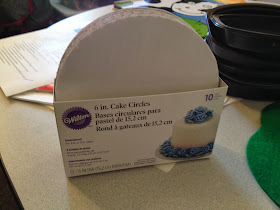I think of the picture above as my "before" picture. Toys sometimes got picked up, although staff were in there more times than not. Things ended up looking messy and didn't make the best use of the space. In addition, some of the puzzles were worn out or missing pieces.
Here's "before" picture number 2. I don't know if you can see it, but there are giant black scuff marks along the side of the Market. Kids had also put stickers on the Market shelves.
Here's what we did:
Step one was to ask our Friends of the Library for money to replace items. While I didn't know everything that we would need, I asked for $500. At my library, toys don't come out of our general budget unless they are for a specific program. We have to ask the Friends.
Step two was a deep clean. While the room is cleaned nightly by the janitorial service and all of the toys are sanitized weekly, there were things getting missed. I hit the room with my Mr. Clean sponge and bottle of Goo Gone (both are a librarian's best friend!). If stuff is dirty or marked, it looks older and in disrepair.
Step three involved sorting and tossing. If things were broken, they were thrown away. This included some of the plastic containers. Broken things tend to have sharp edges that can cut children. Plus, it makes us look shabby. Good stuff was kept and washed.
Step four was the fun one-shopping! This took a month as I love to look for deals and use coupons. For example, I was at Lakeshore Learning 4 separate times because I had four different coupons. I asked staff and other librarians (gotta love Twitter) for their suggestions. In the end, we ended up purchasing:
- 1 flannelboard (we replaced our story time one with the new one and moved the old one into the Activity Room)
- Shape magnets for our giant magnet wall. These included Eric Carle shape magnets, transportation magnets, and animal magnets.
- New play food to use at the Market. We had some very strange old food, such as oysters, that kids wouldn't recognize. Our new batch had kid-friendly items such as pizza, tacos, bacon, etc.
- Rainbow color cones (highly recommended from Twitter)
- A large set of Duplo blocks
- Bristle blocks
- My First Match-Ups-sturdy color matching vinyl puzzle.
- Three large-pieced puzzles from Lakeshore Learning-Alphabet Express, Princesses of the World, and Safari Social.
- Sterlite bins of various sizes
Our puzzles tend to lose pieces or get mixed up. To help cut down on this, each of the pieces was labeled with our library abbreviation and a number. These numbers coincided to a puzzle.
This way if I have to sort pieces, I can do it easily by looking at the backs of the puzzles.
The puzzle number is also next to the name of the puzzle on the label.
A picture of the finished puzzle was also added to the puzzle lid (more for my benefit than the kids').
Here is what the finished product looked like:
Because this is an Activity Room in a public library, I also wanted to be obvious about promoting early literacy. This isn. t just a giant toy room. I started with a sign promoting the five ECRR2 practices.
I also added 2 sign holders to our giant magnet wall. One is going to rotate and emphasize different kinds of play. Right now it is about magnet play. Parents always love when I talk to them about skill building and different ideas. This way, it is accessible all the time.
Our second sign is asking kids to clean up. Cleaning up is a skill, both for parents and for kids. To help with the efforts, we are bribing the kids with stickers that I purchased from Smilemakers.
The Results
Both the parents and the kids are excited about the new toys. The Bristle Blocks have been very popular, along with the new magnets. When I have the chance, I stop in to play with the kids and talk to the parents. This gives me a chance to promote our Friends of the Library group and talk about what they do. I also can touch base with parents, ask about programs, and other stuff about the library.
Yes, staff still have to clean up the room, but it doesn't take as long or need to happen as often now. It tends to be just at the end of the workday. I go in and do a deep sort of toys about once a week Toys do end up in the wrong bins, but at least they aren't scattered all over the floor. I am a little surprised we haven't gone through more stickers. It seems that kids and parents are naturally cleaning up now.


















































